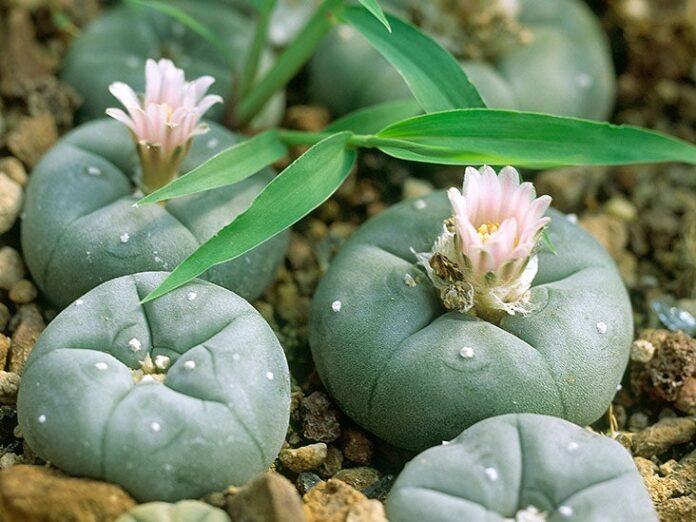ADVISORY WARNING: Unfortunately, peyote is currently endangered and represents a major conservation crisis. The cacti grow and mature slowly, and demand for peyote, particularly for recreational and touristic purposes, has put an enormous strain on this vulnerable species. Many indigenous elders who work with peyote have requested that peyote not be used outside of the Native American churches in which it is a sacrament. For these reasons, Psychedelic Experience does not in any way support the use of peyote, and information about peyote is provided for educational purposes only, with no intention to encourage consumption of this endangered species. For those who are interested in journeying with mescaline-containing cacti, San Pedro (huachuma) provides a comparable experience and is not endangered.
To find out more about the ways in which peyote is endangered, go here, and here. For a comprehensive overview of the legal and ethical situation surrounding peyote, check out this article.
What is peyote?
Peyote (Lophophora williamsii) is a cactus species that is native to the Southwestern United States and Mexico. Peyote is small and grows close to the ground, producing globular “buttons.” The primary psychoactive ingredient in peyote, as in San Pedro, is mescaline. Traditionally, peyote buttons are chewed or brewed into a tea.
What is the peyote experience like?
The effects of peyote usually arise within 30 minutes of consumption and peak after 2-4 hours. Physical symptoms are often uncomfortable, including sweating, nausea, and/or chills. As with San Pedro, the experience is often characterized by euphoria, a mystical state, and enhanced empathy.
A brief history of peyote
For millennia, peyote has been used in indigenous, pre-Colombian cultures for ceremonial and spiritual purposes. The name originates in an Aztec word, peyotl. Under the American Indian Religious Freedom Act, peyote is one of few psychedelic substances that is currently legal for ceremonial use in the United States. Peyote is one of the first psychedelics to enter mainstream consciousness in the West, particularly through the works of Carlos Castaneda. Unfortunately, over-harvesting and recreational use has now caused the plant’s current endangered status.
Peyote Safety
Although long-term research is limited, mescaline (the active ingredient in peyote) appears to be relatively safe. There are no known incidences of a lethal mescaline overdose, and a lethal dose has not yet been identified.
At very high doses, however, adverse effects can include hyperreflexia, tachycardia, agitation, muscle stiffness, ataxia, seizures, mydriasis, sialorrhea, hyperthermia and paresthesia (Dinis-Oliveira, Pereira, Dias de Silva, 2019). Some adverse effects appear to be limited to naturally-occurring mescaline.
One study examined the use of peyote in a ceremonial context among Native American populations and found no adverse effects (Halpern et al., 2005). In studies involving extremely high doses administered to lab rats, there was some evidence of impairment to problem-solving and memory, but the doses in the study far exceed any known human dose (Koupilová, Henrink & Krs, 1999).
Links have been established between mescaline and fetal abnormalities, so pregnant or breastfeeding women should avoid mescaline (Meyer, 2011).
Mescaline should not be consumed by individuals who have a heart condition or chronic hypertension. Mescaline should not be mixed with other medications or substances, especially medications for hypertension, alcohol, immunomodulators, and stimulants (e.g. amphetamines or cocaine).
When ingesting mescaline, always follow basic psychedelic safety recommendations, including attention to set, setting, and sitter. Check out the PEx general safety guide.
Peyote Science
Pharmacology
Peyote contains many different alkaloids, including hordenine, ahaloninidine, tyramine, and pellotine. All of the alkaloids have some degree of psychoactivity, but the primary psychedelic alkaloid in peyote is mescaline.
Mescaline has a phenethylamine structure. As a phenethylamine, it is similar to MDMA, but falls in a different class from tryptamines, such as LSD, DMT, and psilocybin.
Like most psychedelics, however, mescaline acts upon the brain’s serotonergic system, particularly serotonin 2A receptors. In addition to interacting with serotonin receptors, mescaline activates the brain’s dopaminergic system and binds with dopamine receptors.
Therapeutic Use
Because it contains mescaline, peyote has strong empathogenic qualities, like San Pedro. Due to conservation and sustainability issues, however, it is not currently recommended to use peyote in a therapeutic context. San Pedro and MDMA are good therapeutic alternatives to peyote.


